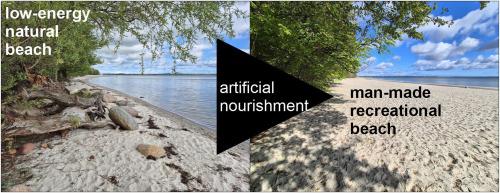低能量海岸的海滩营养:目的和坚持(Puck Lagoon,波兰)
IF 2.6
3区 地球科学
Q1 MARINE & FRESHWATER BIOLOGY
引用次数: 0
摘要
低能量海岸虽然具有重要的生态意义,对人为压力高度敏感,但在人工海滩营养方面的研究仍然不足。本研究考察了沿Puck泻湖(波兰波罗的海南部)的两个地点的海滩营养干预的目的、地貌影响和持久性。Puck泻湖是一个半封闭的、有遮蔽的低能量海岸系统,具有高生态价值,暴露在强烈的旅游压力下。利用基于无人机的形态调查、档案遥感数据和沉积物分析,我们评估了营养前20年的海滩变化,并监测了营养后两年的演变。结果表明,不存在侵蚀危险;因此,营养主要是由社会经济和娱乐利益驱动的,而不是海岸保护需求。天然海滩狭窄而多样,由鹅卵石、残骸、浮木和植被组成,位于Natura 2000站点内。营养物质用相对均匀的细到中等粒度的沙子代替了这些沙子,甚至比自然沉积物还要细。Rewa的初始形态动力学通过侵蚀较低的海滩和填充近岸来纠正设计缺陷。在两年的监测中,没有发现明显的海岸线退缩或体积损失。在这两个地点,形态动力学仍然很弱,仅仅反映了营养前的模式。我们的研究结果表明,在能量极低的海岸,营养效应可以持续数年而不需要反复干预。我们提出了一个综合地貌、生态和社会经济标准的决策框架,以指导类似环境下的可持续营养规划。这些结果对全球受庇护泻湖系统的综合海岸带管理具有管理意义,强调了严格的需求评估、长期监测和生态系统服务评估的必要性。本文章由计算机程序翻译,如有差异,请以英文原文为准。

Beach nourishment on low-energy coasts: Purpose and persistence (Puck Lagoon, Poland)
Low-energy coasts, though ecologically significant and highly sensitive to anthropogenic pressures, remain understudied with respect to artificial beach nourishment. This study examines the purpose, geomorphological effects, and persistence of beach nourishment interventions at two sites along the Puck Lagoon (Southern Baltic, Poland) – a semi-enclosed, sheltered low-energy coastal system of high ecological value exposed to intense tourism pressure. Using UAV-based morphological surveys, archival remote sensing data, and sediment analyses, we assessed beach changes over the two decades preceding nourishment and monitored post-nourishment evolution for two years. Results indicate an absence of erosion hazards; nourishment was therefore driven primarily by socio-economic and recreational interests rather than coastal protection needs. The natural beaches were narrow and heterogeneous, composed of cobbles, wrack, driftwood, and vegetation within a Natura 2000 site. Nourishment replaced these with relatively homogeneous fine-to medium-grained sand, even finer than the natural deposits. Initial morphodynamics in Rewa corrected design shortcomings by eroding the lower beach and infilling the nearshore. Over two years of monitoring, no significant shoreline retreat or volumetric losses were detected. In both sites, morphodynamics remained weak, merely reflecting pre-nourishment patterns. Our findings demonstrate that, on extremely low-energy coasts, nourishment effects can persist for several years without recurrent interventions. We propose a decision-making framework integrating geomorphological, ecological, and socio-economic criteria to guide sustainable nourishment planning in similar environments. These results have management implications for Integrated Coastal Zone Management in sheltered lagoonal systems worldwide, highlighting the necessity of rigorous need assessment, long-term monitoring, and ecosystem service valuation.
求助全文
通过发布文献求助,成功后即可免费获取论文全文。
去求助
来源期刊
CiteScore
5.60
自引率
7.10%
发文量
374
审稿时长
9 months
期刊介绍:
Estuarine, Coastal and Shelf Science is an international multidisciplinary journal devoted to the analysis of saline water phenomena ranging from the outer edge of the continental shelf to the upper limits of the tidal zone. The journal provides a unique forum, unifying the multidisciplinary approaches to the study of the oceanography of estuaries, coastal zones, and continental shelf seas. It features original research papers, review papers and short communications treating such disciplines as zoology, botany, geology, sedimentology, physical oceanography.

 求助内容:
求助内容: 应助结果提醒方式:
应助结果提醒方式:


